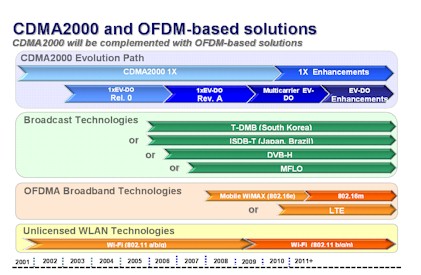|
In today’s
highly-competitive 3G market, wireless broadband
drives future growth while voice remains an
essential element. The trend is to evolve beyond
mobile voice and offer affordable, personal
telephone, Internet and multimedia access without
wires to urban, sub-urban and rural areas. These
services require a reliable and mature technology
that offers a long-term evolutionary path - like
CDMA2000, the world’s most widely-used 3G technology
with more than 463 million subscribers worldwide,
276 commercial networks and 24 more networks in
deployment.
The CDMA
community continues to invest in enhancing CDMA2000
technology to further increase its value and
performance in a very competitive wireless market.
CDMA2000 already leads all 3G voice and broadband
technologies in terms of performance, affordability
and adoption, and over the next two years the voice
capacity of CDMA2000 1X will increase 4 times and
broadband data throughput of EV-DO will be tripled
(see chart below). With these significant
investments and enhancements, 3G will be able to
deliver the performance and user experience that is
expected for next-generation technologies, referred
to as 4G.

CDMA2000 1X
enhancements will quadruple CDMA’s already-excellent
voice capacity, which today already boasts twice as
much voice capacity as UMTS. The enhancements to
CDMA2000 1X include a new vocoder, more antennas,
interference cancellation, additional Walsh codes
for more capacity and a new radio configuration with
less transmit power. The benefits of these
improvements include a lower cost per call thanks to
greater spectral efficiencies (enabling unlimited
voice offerings), as well as more efficient use of
spectrum, which is vital for spectrum-constrained
markets. These enhancements will also enable
opportunities to increase broadband revenue by
freeing up channels that can be used for EVDO
broadband data services.
CDMA2000
1xEV-DO will initially be enhanced via software
upgrades and then hardware to enable spatial
diversity, multi-carrier operations and other
important features. This evolution will bring EV-DO
data rates from 3.1 Mbps downlink and 1.8
Mbps uplink, using EV-DO Rev. A in 1.25 MHz
carrier, to 24 Mbps and 18.6 Mbps in 5
MHz, respectively. EV-DO will offer better speeds,
increased sector capacity, reduced latency, advanced
quality of service features, an IP-based network and
backward compatibility, allowing operators to
leverage their existing subscriber base and network
assets to offer robust mobile broadband Internet
access and related data services to customers.

3G CDMA
technologies will also continue to be complemented
by wider-bandwidth OFDM-based solutions. Just as
operators have expanded their service offerings with
OFDM-based broadcast technologies such as T-DMB,
ISDB-T, DVB-H and MFLO, 3G CDMA will also coexist
and interoperate with LTE and Mobile WiMAX.
CDMA2000 will continue to offer ubiquitous
high-performance mobile broadband and voice services
with a defined evolution path, while OFDM solutions
will augment CDMA2000 capacity by leveraging
wider-bandwidths in high-teledensity areas.
Furthermore, CDMA2000 operators will be among the
first enabled to augment their networks with LTE
and/or Mobile WiMAX, without requiring a GSM or UMTS
network deployment beforehand.
Especially for
rural and sub-urban areas, there is a solution that
is providing affordable network coverage for voice
and broadband data services: CDMA450 (CDMA2000 in
the 450 MHz frequency band). With more than 125
operators in 65 countries and 20 million
subscribers, CDMA450 is the most mature and
widespread solution for providing fixed and mobile
telecommunication services to both urban and
underserved rural markets, enabling economical
voice, “always-on” broadband data and multimedia
services.
CDMA2000
continues to evolve in a highly-competitive global
wireless market. Even as 3G CDMA is augmented by
interoperability with wider-bandwidth solution, such
as LTE and Mobile WiMAX, continued technology
enhancements will ensure CDMA2000’s contribution to
expanding 3G wireless voice and mobile broadband
services to both emerging and underserved markets
for many years to come.
Celedonio von Wuthenau
Regional Director for Latin America
CDMA Development Group |


